#Builders West London
Explore tagged Tumblr posts
Text

Do you want home extension builders Richmond? If yes, then look no further than GLS Building Contractors! It has more than two decades of experience in this field and can widen your space using the latest home design techniques. Our team is well-versed in expanding your home so that you can meet the current requirements. Visit our website or dial 020 8840 5457 for more information!
#Extension Builders Richmond#Extension Builders Kew#Refurbishment Richmond#Builders West London#Builders Ealing#Extension Builders Ealing#Kitchen Installers Ealing#Refurbishments Ealing#House Remodelling Ealing
1 note
·
View note
Text
Efficient rubbish removal in Kingston | Rubbish Waste

Efficient rubbish removal in Kingston! We handle waste responsibly, offering prompt services for homes and businesses. Clear clutter with ease. Eco-friendly solutions for a cleaner environment. Contact us for hassle-free rubbish removal! https://www.rubbishwaste.co.uk/
0 notes
Text
Contemporary Bedroom

Inspiration for a small, modern guest bedroom remodel with a beige floor, coffered ceiling, and wallpaper.
0 notes
Text
Transform your house into a dream home with our professional house renovation services. Momi Construction is a trusted home renovation company specialising in comprehensive home remodelling, extensions, and more. Contact us for a free consultation.
#Home Refurbishment Experts#North West London Contractors#Construction and Renovation Services#Garage Conversion Specialists#Quality Craftsmanship#Experienced Builders#Custom Home Design
1 note
·
View note
Photo

Gym Multiuse Mid-sized trendy medium tone wood floor, brown floor and coffered ceiling multiuse home gym photo with beige walls
0 notes
Text
A walk through Bengal's architecture
Bengali architecture has a long and rich history, fusing indigenous elements from the Indian subcontinent with influences from other areas of the world. Present-day Bengal architecture includes the nation of Bangladesh as well as the Indian states of West Bengal, Tripura, and Assam's Barak Valley. West Bengal’s architecture is an amalgamation of ancient urban architecture, religious architecture, rural vernacular architecture, colonial townhouses and country houses, and modern urban styles. Bengal architecture is the architecture of Wind, Water, and Clay. The Pala Empire (750–1120), which was founded in Bengal and was the final Buddhist imperial force on the Indian subcontinent, saw the apex of ancient Bengali architecture. The majority of donations went to Buddhist stupas, temples, and viharas. Southeast Asian and Tibetan architecture was influenced by Pala architecture. The Grand Vihara of Somapura, which is now a UNESCO World Heritage Site, was the most well-known structure erected by the Pala rulers.

The Grand Vihara of Somapura
According to historians, the builders of Angkor Wat in Cambodia may have taken inspiration from Somapura. Bengal architecture became known for its use of terracotta due to the scarcity of stone in the area. Clay from the Bengal Delta was used to make bricks.
The temple architecture has distinct features like the rich wall decoration, often known as the terracotta temples, which was one of the remarkable elements of Bengali temple architecture. The double-roofed architecture of thatched huts was replicated by Bengali temples. Square platforms were used to construct the temples. Burnt brick panels with figures in geometric patterns or substantial sculptural compositions served as the temples' adornment.

Dochala style
These served as models for many temples that were built in undivided Bengal. Construction materials used in ancient times included wood and bamboo. Bengal has alluvial soil, so there isn't a lot of stone there. The bricks that were utilized to build the architectural components were made from stone, wood, black salt, and granite. Bengal has two different types of temples: the Rekha type, which is smooth or ridged curvilinear, and the Bhadra form, which has horizontal tiers that gradually get smaller and is made up of the amalaka sila. Mughal architecture, including forts, havelis, gardens, caravanserais, hammams, and fountains, spread throughout the area during the Mughal era in Bengal. Mosques built by the Mughals in Bengal also took on a distinctive regional look. The two major centers of Mughal architecture were Dhaka and Murshidabad. The do-chala roof custom from North India was imitated by the Mughals.

Jorasako thakurbari
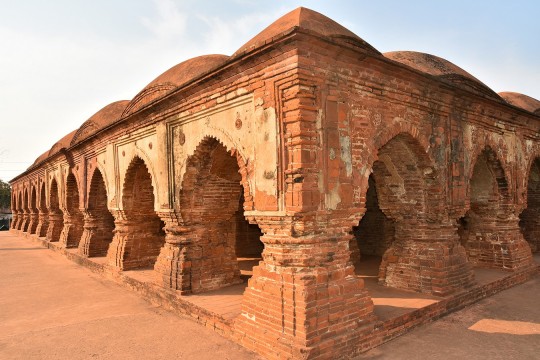
The Rasmancha is a heritage building located at Bishnupur, Bankura district, West Bengal.
Influence of the world on Bengal architecture: Although the Indo-Saracenic architectural style predominated in the area, Neo-Classical buildings from Europe were also present, particularly in or close to trading centers. While the majority of country estates had a stately country house, Calcutta, Dacca, Panam, and Chittagong all had extensive 19th and early 20th-century urban architecture that was equivalent to that of London, Sydney, or other British Empire towns. Calcutta experienced the onset of art deco in the 1930s. Indo-Saracenic architecture can be seen in Ahsan Manzil and Curzon Hall in Dhaka, Chittagong Court Building in Chittagong, and Hazarduari Palace in Murshidabad.
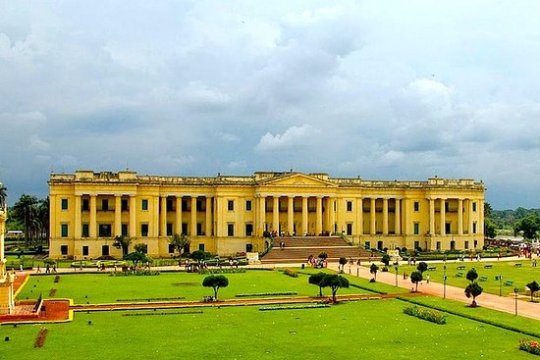
Hazarduari Palace in Murshidabad
The Victoria Memorial in Kolkata, designed by Vincent Esch also has Indo-Saracenic features, possibly inspired by the Taj Mahal. Additionally, Kolkata's bungalows, which are being demolished to make way for high-rise structures, have elements of art deco. The 1950s in Chittagong saw a continuation of Art Deco influences. The Bengali modernist movement, spearheaded by Muzharul Islam, was centered in East Pakistan. In the 1960s, many well-known international architects, such as Louis Kahn, Richard Neutra, Stanley Tigerman, Paul Rudolph, Robert Boughey, and Konstantinos Doxiadis, worked in the area.

The Jatiyo Sangshad Bhaban
This iconic piece of contemporary Bangladeshi architecture, was created by Louis Kahn. Midsized skyscrapers dominate the cityscapes of contemporary Bengali cities, which are frequently referred to as "concrete jungles." With well-known architects like Rafiq Azam, architecture services play a key role in the urban economies of the area. Overall Bengal architecture was influenced by various contemporaries of their time and continues to evolve.

Gothic architectural style seen in St. Paul's Cathedral in Kolkata.

Zamindar era buildings in ruin.

Belur Math in Howrah
#bengali#bangla#west bengal#bangladesh#tripura#assam#desi#বাংলা#india#architecture#tales#bengal architecture#history#kolkata#international#technology#information#temple#asia#bricks
186 notes
·
View notes
Text






On October 17th 1850 James Young obtained the patent for the extraction of paraffin from shale.
The following year the world's first commercial oil refinery followed opened.The chemist-cum-businessman James Young, later known as "Paraffin" Young, opened a works near Bathgate that produced lubricating oils and naphtha (for use as a cleaning solvent) from the shale found among West Lothian's coal deposits.
Soon he developed technologies that produced paraffin for lights – Bathgate oil lit a quarter of London's lamps – and paraffin wax for candles. In the 1860s, when many of Young's patents expired, Scotland became gripped by oil mania as dozens of hastily established companies dug pits and erected retorts and refineries in a small stretch of countryside to the south of the Forth.
During its first boom, the shale oil industry employed more than 30,000 people, many of them migrants from elsewhere in Britain. Existing villages grew at a rate bewildering to those who lived in them – Broxburn's population went from 660 to 5,898 in 30 years – while entirely new settlements of brick cottages, with perhaps a store or a working men's institute at their centre, appeared suddenly where no one had previously thought to live. By the 1910's West Lothian shale produced 27.5m barrels of crude oil, which was roughly 2% of then world production.
As the 20th century progressed oil from the Persian gulf became more abundant and cheaper to produce, the second world war and oil shortages prolonged the shale business but the writing was on the wall. The last shale mine closed in 1962, and then it was gone. The pitheads, the retorts, the refineries and the narrow-gauge electric railway that connected them: all vanished, leaving the spoil heaps, the bings, as the most visible evidence that industry had ever existed.
Just north of my home town of Loanhead lays Straiton, not retail parks and most famous for the large Ikea there, but back in the day it was part of the shale works that stretched across the Lothians, all that is left of the Straiton Oil Company are a row of cottages, the head office was in a building that eventually was converted into a pub, The Callyr Inn, sadly the people that bought it years after it closed let it rot, deliberately making it so unsafe that it was pulled down to be replaced by more warehouse type units.
Two of the bings remain, Greendyke and Five Sisters, as industrial monuments protected in law against excavation and reshaping by road builders who want their red waste as hardcore. Whether you love them or hate them the bings are there to stay, as a reminder to a once thriving mining industry around the lothians,, my fave is Greendyke, if you like a good walk, apparently they call it Bing Bashing, it offers great views, you can see the Ochils to the north and the Pentlands to the south, the strange cone of North Berwick Law away to the east and it's possible to make out the shape of Ben Lomond to west, on a clear day. Edinburgh Castle and the Forth bridges are easily picked out and if you walk to the northern edge,you can look down on Niddry Castle, a 15th-century keep where Mary Queen of Scots once spent a night.
There's loads of history, first is the official Shale Oil Museum webpage, promoting the museum itself, it will take you weeks to get through everything here https://www.scottishshale.co.uk/index.html
Pics are James "Parafin" Young, some old pics of the industrialisation, an old Farm eaten up by the plants and pics of the Greendyke bing, with Niddry Castle and Five Sisters Bing from the air
11 notes
·
View notes
Photo
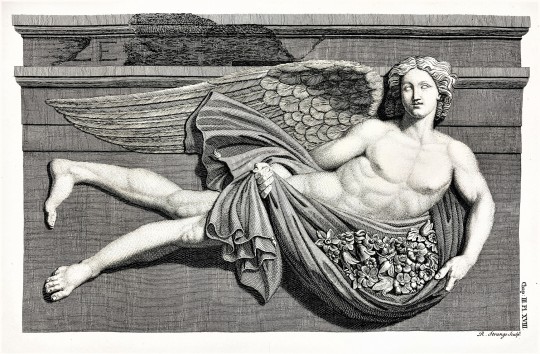
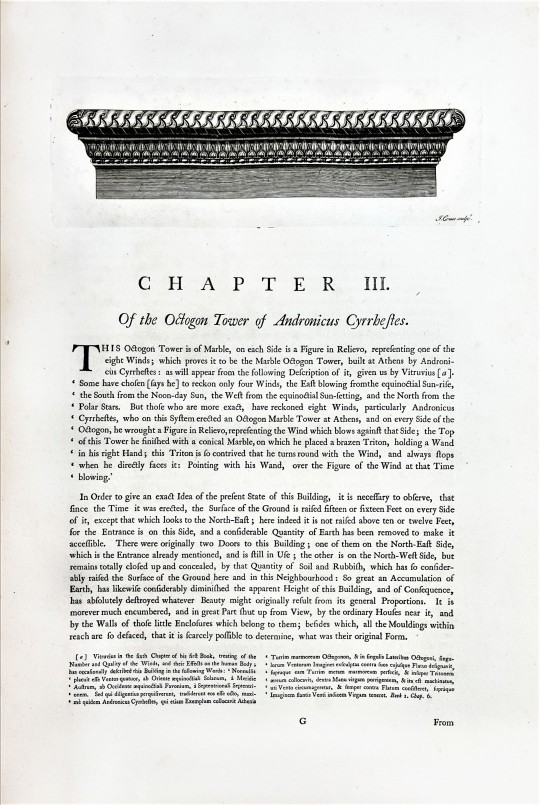




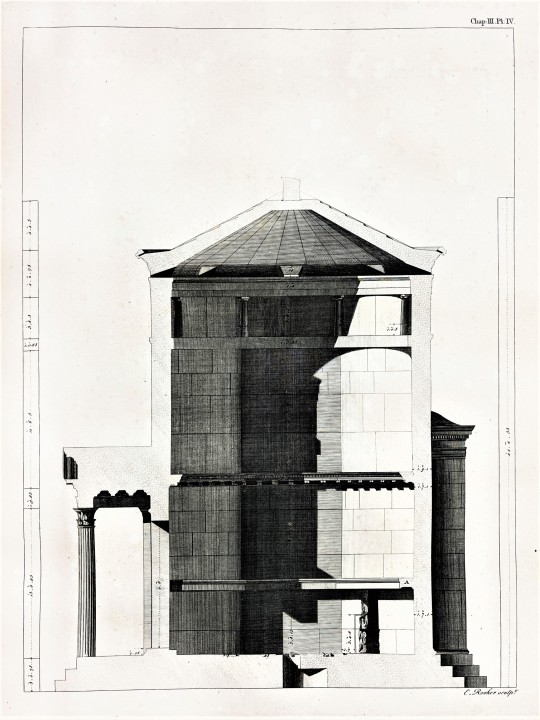
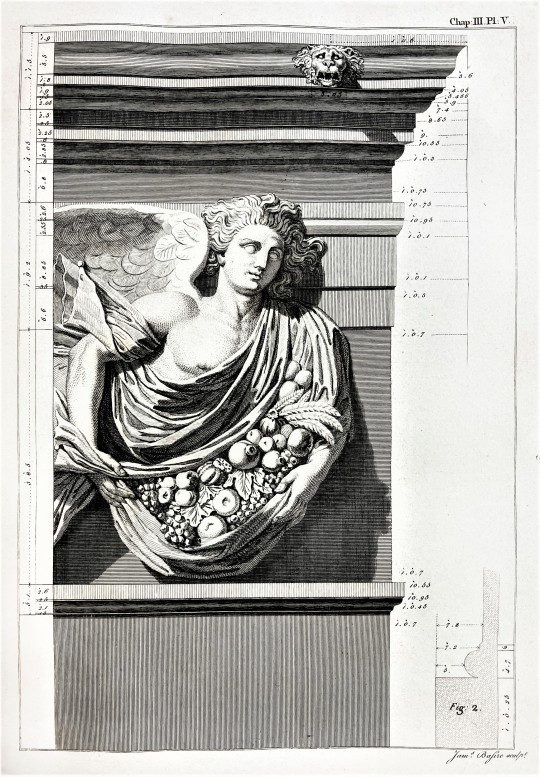


Decorative Sunday!
These beautiful engravings are from the first volume of The Antiquities of Athens by Scottish archeologist, architect and artist, James Stuart (1713-1788) and British artist and architect, Nicholas Revett (1720-1804), printed in London by John Haberkorn in 1762.
The Tower of the Winds is an octagonal marble clock tower in the Roman Agora of Athens. It was designed by Andronicus of Cyrrhus around 50 BC. It was a functional structure that contained sundials, a waterclock, and a wind vane. It is an ancient equivalent of a modern day meteorological station. The building became more widely known outside of Greece because of Stuart and Revett, who were among the first to document the antiquities and monuments of Athens in great architectural detail. Their work is noted for fueling the Greek Revival, an architectural movement in northern Europe, the United States, and Canada in the late 18th and early 19th centuries. When the first volume was published they had more than five hundred subscribers, mostly architects and builders.
The engravings were made by the British engraver James Basire (1730-1802), who specialized in prints depicting architecture. Artwork by Basire is held in museums throughout the world. He is also known for having the young William Blake (1757-1827) as an apprentice for seven years.
The well known artist William Hogarth (1697-1764) published a satirical print called The Five Orders of Periwigs in which he classifies the ridiculous wigs that were in fashion at the time into “orders” with greatly detailed measurements. This was a direct satire of Stuart and Revett’s work and similar work of which he said “It requires nor more skill to take the dimensions of a pillar or cornice, than to measure a square box.”
The tower’s frieze depicts the eight winds in bas-relief represented figuratively as gods, the Anemoi: Zephyrus, the West wind; Boreas, the North wind; Kaikias, the North East wind; Apeliotes, the East wind; Eurus, the South East wind; Notus, the South wind; Lips, the South West wind; and Sciron, the North West wind.
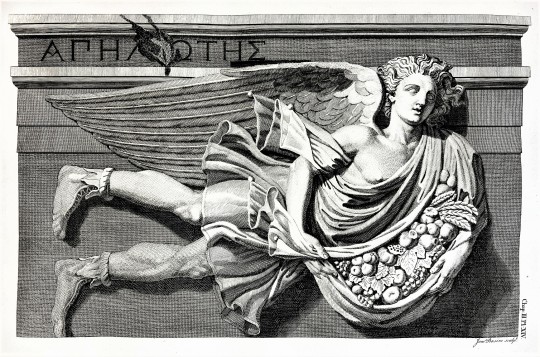
Apeliotes, The East Wind.

Eurus, The South East Wind.

Notos, The South Wind.

Lips, The South West Wind.

Sciron, The North West Wind.
View more Decorative Sunday posts.
-Teddy, Special Collections Graduate Intern
#Decorative Sunday#decorate plates#decorative arts#tower of the winds#athens#greek mythology#greek architecture#architecture#the antiquities of athens#james stuart#nicholas revett#James Basire#Andronicus of Cyrrhus#John Haberkorn#William hogarth#weathervanes#Engravings#18th century#greek sculpture#roman mythology#roman architecture#archeology#Teddy#Roman Agora#athens greece#Ancient Greece
105 notes
·
View notes
Text
The Sun in summer 2022:
The Cambridges' new pad Adelaide Cottage needs no extra taxpayer-funded security or costly refurb. It's understood the family will have no live-in staff, with any aides commuting to Windsor instead. And sources say they dream of a "modest" home with a garden so the children can play outside together. One insider told The Sun: “They were adamant they didn’t want anything too showy or anything that needed renovating or extra security so as not to be a burden on the taxpayer." The property was modernised back in 2015.
The Daily Mail in June 2022:
Prince William and Kate Middleton will move their family into a four-bedroomed home on the Windsor estate this summer. The Duke and Duchess of Cambridge, are reportedly set to uproot their family from Kensington, west London, to Adelaide Cottage in Berkshire in order to be closer to the Queen. Re-erected in 1831, the Cambridge’s new Grade II-listed retreat is just a short walk from St George’s Chapel and Windsor Castle, and sits proudly on the 655-acre royal estate in Berkshire.
Victoria Ward for The Telegraph on 14 August 2022:
But in the coming two or three weeks, the Duke and Duchess of Cambridge will do the opposite, swapping their grand Kensington Palace home for a relatively modest four-bedroomed cottage on the Windsor estate, a move that will see them navigate life without a live-in nanny for their first time in their children’s lives. [...] Although Ms Borrallo will be kept on full time, she will live elsewhere, as will the handful of other support staff that have long “lived-in” with the family at Kensington Palace, thought to include a housekeeper and a chef.
The Sun on 03 September 2022:
“They had to have moved in this weekend, because the children have to start at their new school next week. “The renovation is no-frills, by royal standards — and is certainly in stark contrast to the £2.4million work Harry and Meghan had done on Frogmore Cottage. It will have been a builder’s finish.” Kate and William spent around a year searching for a home in Windsor so the children could go to school together. They settled on Adelaide Cottage, as first revealed by The Sun, because they believed it needed no major renovations. They decided to go with existing furniture and fittings but had a fresh coat of paint to make it feel like home for the children.
LESS THAN TWO YEARS LATER...
The Mirror on 15 April 2024:
Prince William and Kate Middleton are reportedly hatching surprise plans to transform a secret home into something of a sanctuary as part of the Princess's recovery process. The Royal couple is said to be contemplating renovations and extensions to a little-known redbrick annexe adjacent to their Adelaide Cottage residence in Windsor. The family, who relocated to the Berkshire estate towards the end of summer 2022, currently divide their time between the four-bedroom cottage and their cherished Anmer Hall retreat on the Sandringham Estate. While Adelaide Cottage offers an ideal location due to its closeness to Lambrook School where Prince George, Princess Charlotte and Prince Louis attend, insiders suggest the family are considering plans to expand a currently vacant annexe to assist in the princess' recuperation. However, this decision is not without its challenges, as sources indicate that the Prince of Wales is "conscious of public scrutiny" regarding Royal expenditure and is taking a cautious approach to personally funding the costs. "They [William and Kate] absolutely adore Adelaide Cottage, but it just about fits the entire family, whereas Anmer Hall is much larger with extensive grounds," the source revealed to OK!. "Adelaide Cottage is being used as a term time property while the children are at school nearby and Anmer Hall is for long weekends and holidays." Insiders have spilled the beans on plans to revamp a run-down redbrick annexe at Adelaide Cottage, aiming to turn it into a perfect retreat for the Wales family and their aides. While the project is on pause as the Princess of Wales focuses on her recovery, the plans are reportedly simmering away in the background, ready to spring into action when the time is ripe. "Nobody knows that there is quite a spacious red-brick annexe building that's not being used next door to Adelaide Cottage," an insider said. "It's currently inhabitable and needs extensive renovation works if it were to be used. Discussions have been ongoing for a while about using the property as part of the overall cottage grounds, but it's just about finding the right time to kick the project off." The need for space is more than a luxury; sources say it's vital for Kate's path to wellness, providing her with a serene environment to manage her treatment's demands. Anmer Hall is the top pick at the moment, thanks to its generous size and seclusion. Mindful of past backlash over public funding, the Wales clan is considering footing the bill for the Adelaide Cottage annexe's refurbishments themselves. "William is very conscious of the public scrutiny over the Royal Family's spending habits, so he is looking at the best way to cover any renovation costs," a source revealed. "It's a project that's very much been put on the back burner for now due to the family's unfortunate position, but it will be looked at again when the time is right." Adelaide Cottage, tucked away in the Crown Estate's private 655-acre Royal park, was originally constructed in 1831 as a sanctuary for the wife of King William IV, Queen Adelaide. The cottage underwent significant refurbishments in 2015 and boasts some seriously opulent decor. It's said that the master bedroom's ceiling is adorned with gilded dolphins and rope ornamentation, according to various reports.
Well, well, well...
Adelaide Cottage "just about fits the entire family."
"Just about" but not quite, apparently.
Is four bedrooms no longer enough? It was perfectly fine two years ago when they selected it as it "needed no major renovations."
But Kate needs this annex renovation completed for her "path to wellness"? I've never heard of a person undergoing "preventative chemotherapy" needing extensive renovations to their personal real estate to improve their health, particularly when they already have above average living space.
There is a time limit to "preventative chemotherapy." She shouldn't need to be doing "preventative chemotherapy" forever. If she's just doing "preventative chemotherapy," then she should be able to recover within a few weeks after she completes "preventative chemotherapy." (Unless she's really not doing "preventative chemotherapy" to begin with...)
But, hey, if she needs more "space" at home for non-"luxury" reasons, then The Mirror is supporting my previous statement that Kate "is going to be more reclusive for the next year or two."

#fleet street#Matt Wilkinson#Victoria Ward#the telegraph#daily mail#the daily mirror#well well well#Windsor Great Park#real estate#Windsor Castle#Adelaide Cottage#pr games#strategery#kensington palace#palace household#palace staff#kate middleton#Catherine The Princess of Wales#William The Prince of OWN GOALS#William The Terrible#William The Weak#prince william#William The Prince of Wales#Prince & Princess OWN GOALS#Wales fandom ARMAGEDDON#my gif
7 notes
·
View notes
Text

COSMOPOLITAN UK | A few weeks ago, Charithra Chandran was having a dinner party with some of her oldest friends. A few of them work in advertising and marketing, another is a doctor, one is a lawyer. None work in ‘the industry’. ‘Have I changed?’ Chandran asked them, as plates were cleared and wine glasses topped up. Their answer was unanimous. ‘No way.’ ‘In fact,’ one joked, ‘it’s actually sad how little character development there’s been.’ They all laughed. ‘Sometimes dickish things come out of your mouth like, “I’ve got a fitting with Dior next week!” Look, your life might have changed, but you certainly haven’t.’
Their words reassured Chandran of something she already knew. In just two life-changing years, she had gone from being a philosophy, politics and economics graduate preparing to start a job in management consultancy, to playing a lead in one of the biggest TV shows of the past decade. In the year since she appeared in Bridgerton’s second series, caught in a love triangle with Jonathan Bailey’s Anthony Bridgerton and Simone Ashley’s Kate Sharma, her trajectory has shown no signs of slowing down. This year, she stars in a handful of films including Good Intentions, a short with Micheal Ward (who you’ll know from the Oscar-nominated Empire Of Light), as well as playing the lead in teen rom-com How To Date Billy Walsh. And just a few weeks ago, she was in India with Ashley for the Dior pre-fall show (hence the fitting), which she describes as ‘special and incredible’. But while 26-year-old Chandran may be sitting front row, booking lead roles and appearing on magazine covers, she still feels like that same wide-eyed graduate, the one with no idea what would come next.
‘My life just feels so... normal?’ says Chandran, over a builder’s tea in one of her favourite central London cafes, her hair slicked back in a silk headscarf. 'That is the number one thing that has left me feeling sane. I worry that if my personal life was fully in this world, these crazy experiences would start to feel normal. I need to be surrounded by people not involved in the craziness.'
Most of her friends – like the ones at the dinner party – are from school and university, and the industry friendships she has tend to be with older women, including her Bridgerton cast mates Golda Rosheuvel (Queen Charlotte) and Shelley Conn, who played her mother in the series. ‘We hang out all the time. We go see shows; we grab tea or dinner. Golda’s so cool, sometimes I wonder why she wants to hang out with me. Shelley is literally like my older sister; I’m super close with her family. They both give me advice constantly about how to hold yourself in the industry. They provide perspective as well; they’ve been in it for so long, and they’re both women of colour; they remind me how far we’ve come and how far we have to go. Everything that I go through, they’ve been through it tenfold. I really rely on their counsel.’
The road to Bridgerton
Chandran auditioned for the show in 2020 before the first series had aired. At the time, her career as an actor was precarious. She’d loved performing for as long as she could remember (‘I was that annoying kid who always wanted to be the centre of attention’), acting throughout school and university, even performing in the West End with youth theatre companies, but she’d never really considered it as a viable career. ‘I never even talked about wanting to act because I felt embarrassed. Saying you wanted to be a professional actor felt like saying you wanted to be prime minister or an astronaut.’ Her reasons were twofold. The first was a lack of South Asian representation on screen and stage, – ‘For a long time I didn’t really have any inspiration to look towards,’ she says – and the second was familial expectation. ‘I’m the literal opposite of a nepo baby. My parents are doctors; we didn’t know any actors or journalists. Anyone who’s not a medic was foreign territory for us.’
Though her parents hoped Chandran would follow them into the profession, she credits their progressive attitudes with giving her the courage to follow her dreams. ‘They always expected academic excellence, but they gave me so much freedom and trust. I don’t know if that was an active choice or [if] it was because they were immigrants, junior doctors and single parents who didn’t have time to be focused on me 24/7. Either way, they really let me be me.’
Being herself meant giving acting a serious shot before starting the management consultancy job. She deferred the start date for a year and, in between working as a tutor and running a food bank, spent time crafting a CV and a showreel to try to get professional representation. Her graft paid off, and she signed to an agent who began to get her auditions for film and TV roles. Her first was a Bollywood dancer in the star-studded Marvel film Eternals, which Chandran landed after finding an advert on Instagram, helmed by the likes of Angelina Jolie, Richard Madden and Salma Hayek. On set, it was Kumail Nanjiani who really stood out for Chandran. ‘Being on a proper movie set with this fellow brown actor looking buff felt amazing. He treated us with so much kindness and grace.’
Shortly after, Chandran landed a role in Amazon Prime’s Alex Rider series, and then came her even bigger break: Bridgerton. The process was turbulent. The world had gone into lockdown and after a handful of virtual auditions for Ashley’s role (Kate), Chandran was told she looked too young for the part. Months later, out of the blue, she was approached again, and by that point, season one was already out and the show was a breakout hit that became the most-viewed English-language series onNetflix at the time. ‘While they continued looking for Kate, they had me on the back burner. I’d got a part in another show, so I was like, you know, okay, I love the sound of Bridgerton, butI have [other] work so, whatever. And then season one came out and I was like, “Oh, man! It’s such a good show. I would have loved to get that!”’ This time, the team wanted her to audition for the role of Kate’s younger sister, Edwina Sharma. ‘I desperately wanted to be in the show, but I didn’t want to do it solely for that – which is such an ego trip! I only had one credit at the time. But I was fully being like, “Okay, tell me more about the role...’ So I read for it, and then I didn’t hear about anything for months. I was like, “Okay, well, clearly it’s over!”’
Then, one afternoon, while helping out in her mum’s allotment, she received a call asking her to audition with Bailey and Ashley. ‘I didn’t even realise I was still in the running. But the chemistry read was so special. I remember they looked so beautiful on Zoom. The lighting was amazing, and I was in my dingy dining room in the dark. I thought, “Okay, I need to step up my game.”’ Clearly she was already bringing her A-game because she landed the part.
Surviving the spotlight
Bridgerton has a habit of launching the stellar careers of its leads. Almost overnight, season one’s Phoebe Dynevor and Regé-Jean Page went from emerging actors to household names. ‘So many of the cast members who’d been through it were like, Charithra, get a therapist because this is crazy,’ she remembers. She took their advice, and while therapy has been invaluable, nothing could truly prepare her for such a life-altering experience. She cites events in particular as ‘anxiety-inducing’, explaining, ‘There’s an impostor syndrome there. I leave and I want to cry every time!’ It sounds intense, and the internet’s opinions only exacerbated it. ‘I think when anyone is first exposed to this [fame] on the level that I was, they read the comments, they google themselves. And when you read the really aggressive ones – I know this sounds dramatic – but you feel really vulnerable. I’m a normal person – I’m taking the bus, I’m taking the Tube. You’re thinking all it takes is one person being slightly too deranged and trying to hunt you down... It took me like a solid four months to [get] through that.’
When it comes to social media generally, and whether she feels any pressure with what she posts and the persona she presents, Chandran is typically low-key. ‘I’m not famous enough for people to care about me enough to feel that now! I’m not thinking to myself at any point, “I wonder how the public will receive it.” Maybe I should! But even if – fingers crossed – I continue to do really cool things, and I do get more famous, I’m a very open person. I’m not trying to hide anything. I’m very active on social media and I share loads of parts of my life. But that’s what I’d be doing anyway, even if I wasn’t doing this. I don’t do things differently because I have a platform.’
One thing she is clear on: she doesn’t read negative comments any more and focuses her attention on what a powerful impact the series has had, particularly for young women of colour. ‘I get so much energy and enrichment when I meet someone who’s watched it and tells me how much seeing Simone and me on the show means to them.’ She adds, ‘She is so beautiful. We both went through a baptism of fire together, so we really bonded for life over this very seismic experience that we had. We’re connected by something so big.’
Chandran is clearly proud of the show, however not all responses to Bridgerton have been positive. While the Shonda Rhimes Regency-era romance has largely been praised for the diversity of its stars, some critics have questioned the casting, suggesting it’s tokenistic and that the characters of colour aren’t afforded sufficient context or cultural recognition and could just as easily have been played by a white actor. ‘It’s not a perfect show,’ says Chandran. ‘No one’s out here saying this is a perfect representation of anything. If we were to do it again, I’m sure we’d make certain different decisions, but it’s a damn good try. And it’s a really bold try. Let’s enjoy the fact that we have this and continue striving for more.’
Chandran says some of the commentary that bothered her the most were ‘the comments that said I only got to where I am because I’m Eurocentric or I’m white-passing. That really bugged me because all my life I’ve had to face prejudice for not being those things. I have a quintessentially Tamil face, not even Indian, people can place me as a Tamil. You open books, you go to a temple, you see the pictures and paintings; they look like this. So it’s like, bro, I didn’t go through prejudice and discrimination for you to now belittle my identity. When the show was coming out, that’s all I could focus on.’
From Regency to romance
As she gears up for the release of her next project, How To Date Billy Walsh, this time around, her feeling is one of excitement. She plays Amelia, a precocious teenager who, much like her Bridgerton character, finds herself caught up in an unlikely love triangle with her best friend Archie (played by Heartstopper’s Sebastian Croft) and an elusive new student (Cobra Kai’s Tanner Buchanan). The film brims with all the fun, campness and nostalgia of a classic romcom. ‘We wanted to make something that was really timeless,’ says Chandran. ‘My cousins who are 12 and 13 are still watching Clueless, The Breakfast Club, Ferris Bueller’s Day Off. We wanted to do something fun and heart-warming that harked back to the 90s.’
While classic teen romances are praised for their charm, they’re less celebrated for their diversity. As a woman of colour, did it feel like a big deal to be at the helm of a high school romcom? ‘I think it’s so interesting because what I really loved and appreciated was how not a big deal it felt, and I think that’s a real testament to all the people that have come before me, all the directors, producers, actors who have paved the way. I love representing my culture, and I love playing characters who are culturally specific to me,’ she says, ‘but on the flipside, I also enjoy playing a normal person where the story isn’t just about her being Indian. That is what I want for my career as well. I want to do things about race that start important conversations, and things about love and friendship. I don't want to be a one-trick pony.' When choosing roles, she says her approach is simply to find characters who feel truthful. 'The times I've said no are if it perpetuates bad or lazy stereotypes, if it's a character I've already seen before.'
As a romantic lead, her performance is effortless. Amelia is a plucky teenager who reels through the full spectrum of emotions when she develops a crush on the titular character, faces off against bullies and navigates some complicated feelings towards her best friend. Her portrayal of a girl caught in the full throes of an all-consuming crush is vibrant and hilarious, but she also imbues Amelia with a real sense of vulnerability.
Chandran shares some of Amelia's confidence and her thirst for new experiences, but her own memories of dating as a teenager were quite different. rowing up in Oxford, she went to an all-girls school. Most weekends involved house parties with boys from the neighbouring schools, where she would be the only one to get, ‘no attention from the guys,’ she remembers. ‘I thought, "Maybe they’re just not attracted to brown girls." I’m curvy; Indian women tend to have curves and fat in different places. All my friends were white and skinny. It was confusing, but I never took it personally. I used to wonder, is it because they see a brown girl and think, “Oh, she probably can't drink, she’s probably really prudish” – what assumptions were they making just from the colour of my skin?’
While she was at university, one of the boys who had been on the same teen house-party circuit messaged her on Facebook. 'This is a guy I’d seen every weekend for almost two years. He said I was cute and asked me how we knew each other. What’s mad is that I didn’t go to uni and have some glow-up. I looked exactly the same at 19 as I had at 15.’ She believes his sudden interest reflected a broader cultural shift towards diversity. ‘By that time, there were more Black and brown women in magazines and in lead roles on TV. I realised, "Oh, I'm trendy. So now you see there’s an attractiveness there. Because I objectively know I don't look different." That kind of shit happened quite a few times.’
Needless to say, Chandan ghosted the message. ‘I’m not a trend,' she says with a playful eye-roll. In life after Bridgerton, she admits dating can be difficult to navigate. She doesn’t use apps because ‘even before the show, people would see me on Instagram or google me. Which we all do, it's fine... but it started to get weird. So it is harder to meet people, but I don't think I'm famous or successful enough to ever have to worry that someone’s dating me for clout’. Plus, she knows what's important in a potential partner. ‘If I think about what kind of person I want to date, the number one thing I'll say is that they need to be a feminist. I'm a feminist, I'm an advocate for women. I went to a girls school, my family is a matriarchy.’
Dating aside, the fact that Chandran’s life hasn’t changed all that much is a testament to her ability to keep both feet on the ground. There’s also perhaps the knowledge that, should she ever find herself changed by fame, her best friends will absolutely be there to bring her back to reality at the next dinner party. ‘They're the most important people to me’ she says. ‘I love to be surrounded by women. I love the men in my life, but I just prefer women. Women made me feel safe, they make me feel heard.'

#charithra chandran#charithrachandranedit#cchandranedit#bridgerton cast#bridgertoncastedit#interview#*charithra chandran#mine
52 notes
·
View notes
Photo

2 Richards
In the early 80s I was working for my dad (a self-employed builder and plumber) in a big lodging-house in Paddington (West London). There were a lot of students living in the property, and one had recently vacated one of the rooms, in which I found a copy of Richard’s Bicycle Book.
I hadn’t been on a bike for about five years, but I read this tatty old paperback from cover to cover over the following couple of days, and Richard Ballantine’s enthusiasm for cycling was so infectious I was consumed with the urge to get back on the saddle as soon as possible.

Richard Ballantine
So I bought a Raleigh Ace road bike from Club Row market in East London for £79 and became a cyclist. Thank you, Richard, you changed my life for the better.

Raleigh Ace (with me on it), 1984
A couple of years later I met Richard Dyer, who bumped my enthusiasm up a few more notches by introducing me to the London To Brighton Bike Ride and once again the passion was infectious. Once my eyes were opened to this wonderful two-wheeled world, there was no looking back. My half-hearted intentions to learn to drive and pass the driving test and get a car were abandoned and have never returned.

Richard Dyer (now a transport and climate campaigner for Friends Of The Earth). This photo is from 1985, and he still rides the same bike today.
Now I’m in my sixties and have been a “serious” cyclist for nigh on forty years and still cycle every day and this is in part thanks to the two Richards above.
Richard Ballantine's contibution to the world of cycling can’t be overstated. If you ride a bicycle - in any capacity - you owe it to yourself to hunt down a copy of Richard’s Bicycle Book and any of his other fine titles.
#biking#bike#biker#bicycle#bicycling#Bicyclist#cycling#cycle#cyclist#richard ballantine#Richard's Bicycle Book#friends of the earth#richard dyer
39 notes
·
View notes
Photo

The Arches is a minimal space located in London, United Kingdom, designed by DHaus. In the heart of North-West London, a team of dedicated designers and builders have spent the last four to five years overcoming numerous challenges, including Brexit, Covid, and global conflicts, to create a unique and innovative housing project.
10 notes
·
View notes
Text
This goes for many northern civilizations too. Despite being pressed to the edge of extinction by colonial brutality, they still survive, and they aren't an ancient mystery.
Taos Pueblo was a central point of trade for the southwest well into the 19th century, and the people who lived there then still live there today. Over a dozen pueblos are still populated by Puebloans today, and the people who live in them can trace their ancestry to many of the abandoned pueblos that dot the region. 'Ancient' Puebloans aren't all that ancient, and aren't the mystery so many people make them out to be.
Cahokia was the largest city north of Mexico, a vibrant center of trade in the midwest built around a massive mound, founded in the 9th century. It was the same size as London in the 12th century- and it may have declined in the 14th century, but the people who lived there still exist in the form of the Peoria Tribe which is headquartered in Miami, Oklahoma today. There may not be 'Cahokians' anymore, but the people didn't vanish. Their culture just grew into something new, like every culture in the cycle of civilizations does.
The Five Tribes (Cherokee, Chickasaw, Choctaw, Muscogee, and Seminole) had towns of thousands that dotted the entire southeastern United States, built around mounds like Cahokia's. Mississippian civilization, commonly called the mound-builders, was vibrant and flourishing from the 9th to 17th century, with hundreds of towns with widespread trade networks and large scale agriculture. Their towns had planned streets, residential and public subdivisions, bureaucratic chiefdoms, and organized militaries.
And then colonizers decided they wanted that land. The Five Tribes were forced west to Oklahoma in the 1830s-1840s. But the people still exist. You can study the Cherokee language at university. You can get arrested by Seminole Lighthorse Police on I-40. You can visit a Muscogee art exhibition in Tulsa. You can hear Choctaw stories about mounds almost 2000 years old, built by their ancestors. The mound-builders are still here, they aren't some ancient mystery. They were just forced to leave their homes.
When one thinks about "ancient" Native American civilizations and ruins... the thing is that... most of them, they weren't ancient. The Inca were not fully conquered by the Spanish until 1572... for reference, the Mona Lisa was painted in 1502 and Martin Luther made the 95 Theses in 1517.. the "ancient" Aztec Empire was younger than the university of Oxford founded in the 11th century, Montezuma lived at the same time than Leonardo Da Vinci... There are castles that are younger than Machu Picchu, those cities were inhabited by millions just a few centuries ago, and some (Cuzco, México), many actually, are still inhabited today. People speak about the Ancient Maya as if it was some mysterious civilization that was lost, and while it was past its prime at the time of European conquest, the Maya still had city-states and were living in the same areas they live today.
There are still millions of people, right now, who speak Quechua, Nahuatl, and Maya in all their dialects, and I'm just talking about the three most well-known civilizations here... there are millions of Native Americans who still speak their languages and practice their culture and beliefs alive, both thriving and struggling today.
Talking about the "Ancient Inca" or "Ancient Aztecs" makes as much sense as talking about the "Ancient Dutch" or the "Ancient Swedes", and it's another way of erasing them, saying that they just aren't around anymore just like say the Sumerians, or that they just weren't relevant to world history. They were contemporaries to modernity and they're still alive today.
You can talk about the Ancient Olmecs or Ancient Chavín though. Because the Inca and the Aztecs are relatively "modern" but their cultures were just the latest from a cycle of civilizations stretching millenia before Christ.
54K notes
·
View notes
Text
OBS Facilities - Central Heating Engineer in London

OBS Facilities, a premier building and architectural design company in London, provides bespoke services and has been delivering customized solutions to clients for over three decades. Our team includes highly skilled architects, designers, project managers, estimators, and builders. We offer comprehensive plumbing services across West London, Ealing, Hanwell, Harrow, Kingston, Wembley, and Middlesex. Our expertise focuses on central heating, boiler systems, and home improvements, led by our central heating engineer in London team. Fully licensed and committed to the highest quality, we work to eliminate illegal gas workers who jeopardize safety, ensuring you and your family are protected.
Website - https://obslimited.co.uk/ Contact Us - 079305 72076 Email ID - [email protected] Address - 40 Walnut Tree Road Heston , United Kingdom
1 note
·
View note
Text
#Builders In Fulham#Building Services#Home Renovations#Refurbishments#Extensions#Conversions#Bathrooms Renovation#Kitchen Renovations
0 notes
Text
youtube
Happy Birthday Mark McLachlan aka Marti Pellow, born March 23rd 1965, the same year as myself.
Picture the scene, a teenage Mark chatting to his dad in Clydebank, and telling him he was going to be a musician, according to Pellow the reply went something like this....'Are you on a hallucinogenic substance or something? What's wrong with getting out there and getting an apprenticeship? I'm a builder, your grandfather was a builder, your great-grandfather was a shipbuilder. What do you want to be a musician for?'
And so it was, Mark became Marti and Mclachlan, became Pellow.
In 1982, at the age of seventeen, Marti formed the band Vortex Motion, with three friends from Clydebank High School in his hometown, the bands name was later changed to Wet, Wet, Wet who went on to have numerous hit singles and albums.
PolyGram signed the group in 1985 and spent a fortune fine tuning them in, the group scored a hit two years later with "Wishing I Was Lucky," which reached number 6 in the charts, the album Popped In Souled Out was a huge success scoring them a debut number one, two more would follow.
The Wets, as they became known had more single success in 1988 with their first number one, a cover of the Beatles' "With a Little Help from My Friends" cut for the charity ChildLine.
Hit singles including Sweet Surrender and Goodnight Girl preceded a 1994 cover of the Troggs' "Love Is All Around" which spent an astounding 14 consecutive weeks atop the charts and was their third chart topper; however, in the wake of 1997's album, 10, the Wets began splintering amid copyright squabbles, and in May 1999 Pellow left the group.
Marti had a few minor hits as a solo artist but soon found fame in London's' West End in the hit stage musical Chicago.
Marti's mother passed away in 2003 and he was touched that all his ex band members attended the funeral, he recalled his mum saying that maybe Wet Wet Wet would get back together sometime and Marti later said in an interview "Moments like that put things into perspective - it wasn't all about music, it was more about a kinship between us." The band reformed the following year.
While the group haven't officially split the earlier success has eluded them, they still attract fans to their sell out concerts, Marti is still playing to audiences in London, his last role being Che Guevara in Evita aside from music he was the narrator in Willy Russell's Blood Brothers in 2015.
Pellow is currently touring singing some of his best-known songs on a UK-wide tour. He'll be playing former band Wet Wet Wet's debut album, Popped in Souled Out, in full - plus a string of other hits. The first night was at in Dublin and he played Glasgow's OVO Hydro last Saturday, he is in Leeds tonight, followed by Newcastle, London, Bournemouth and Birmingham.
11 notes
·
View notes